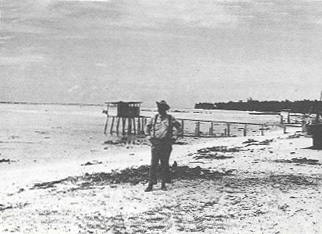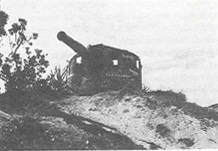Goodbye, Darkness (32 page)
Most of Ieuan's tasks are duller. He is masterminding the transfer of power from British colonial rule to Gilbertese independence. He deals with the islands' elected officials and such issues as water tables, natural resource development, and fishing rights off Christmas Island, one of the Gilberts. The main problem, he says, is that natives on outlying Gilbert islands are moving to Tarawa Atoll. Their expectations were raised during the years of the American occupation — they were given room and board, and paid twenty-five cents a day — and now they want cash wages, dance halls, and a consumer society. Before the war they didn't know that appliances, movies, and private cars existed. Now they do, and they are determined to have them, despite the meager yields of their primitive economy. Had they known I was coming, Ieuan tells me, they would have greeted me at the airport with tawny girls dancing the exotic
maneaba
, because they know visitors expect that of them. But they prefer the Twist. Chubby Checker is their idol. They are addicted to filter tips. On Betio, where young lovers couple in positions described by Masters and Johnson, their slogan is “Betio Swings!”
I decide to nap after lunch. Tropical evergreens decorate the hotel entrance; Christmas is a month away, but already the merchants are psyching up customers who really can't afford their wares. A few skilled workers can; outside my hotel door, interrupting my afternoon nap, are two islanders jabbing at coral with a jackhammer. I think of the Marines who tried to dig in here with entrenching tools. At dusk, as the sky deepens with a lovely flush — “Out here the sun,” Bob Trumbull told me, “sets on the British Empire with style” — I slip into swimming trunks and dive from a coral ledge into the sea. The water is warm, sensual, but when I climb out I am reminded how vicious coral can be. I nick an elbow and open a nasty gash above a knee. Neither is disabling, however; tomorrow I shall take the ferry to Betio. Already the Sergeant in me is brooding about it; I know I can expect a hilltop nightmare tonight. The Twist. Chubby Checker. Betio Swings. Is that why 3,381 Marines of my generation fell here thirty-five years ago?
Both the American
and
the Japanese troops were commanded by admirals — the defenders of the atoll were members of the Japanese Special Landing Forces: Japanese Marines, wearing the distinctive crysanthemum-and-anchor emblem on their helmets — and confidence was high, both on the flagship offshore and in the beach's headquarters bunker. The admiral commanding the American bombardment told Marine officers: “Gentlemen, we will not neutralize Betio. We will not destroy it. We will obliterate it!” A Marine general, Julian C. Smith, replied: “Even though you navy officers do come in to about a thousand yards, I remind you that you have a little armor. I want you to know that Marines are crossing that beach with bayonets, and the only armor they will have is a khaki shirt.” But despite scheduling blunders the warships and warplanes seemed to be doing their best to prepare the way for the landing force. Three U.S. battleships, five cruisers, and nine destroyers had plastered the shore with three thousand tons of high explosives — roughly ten tons per acre. Yet the Japanese admiral remained confident. He had said that “a million men cannot take Tarawa in a hundred years.” Each of his underground pillboxes was built with steel and reinforced concrete, covered with coconut logs and coral, invisible to the American bombers and warships. Underground tunnels, invulnerable even to direct hits, connected the pillboxes and blockhouses. Fourteen huge coastal guns, including the eight-inchers from Singapore, led an orchestra of fifty field-pieces. Over a hundred machine-gun nests were zeroed in on the lip of a four-foot coconut-log and coral-block seawall. The Japs doubted that any of the U.S. assault troops would ever reach the beach, however. The reef standing between them and the Allied fleet was wider than Betio itself. And the Japanese, unlike the Americans, possessed accurate tide tables.
The struggle for the island began in the early hours of Saturday, November 20, 1943. By 4:30
A.M.
the Marines assigned to the first wave had descended their cargo nets, jumped into Higgins boats, and transferred to amphtracs, which began forming for the assault. Japanese ashore were aware of dark hulks in the night but were waiting until the Americans committed themselves to the isle's sea beach or its lagoon side. At 4:41
A.M.
a Nip coastal defense gun fired a red-star cluster over the six U.S. transports. Now they knew: it was to be the lagoon side. Our naval gunfire had been stunning — one Marine said, “It's a wonder the whole goddam island doesn't fall apart and sink” — but it had ended an hour earlier. Two U.S. destroyers laying down a smoke screen for the Marines were shelling the beach, but against such defenses tin-can fire was ineffectual. Japs who had been braced for an approach from the sea leapt into prepared positions facing the lagoon. Now the American Marines would confront 4,836 Japanese, most of them Jap Marines.
Amphtrac coxswains found the seventeen-mile-long, nine-mile-wide lagoon choppy, its current strong, and their screws baffled by a riptide, a tug created by large volumes of water being sucked through underwater gaps in the reef. Instants later, they discovered that the Japs had somehow survived the bombardment. At three thousand yards from shore enemy artillery opened up on them; at two thousand yards they came under fire from long-range machine guns, and at eight hundred yards, as their awkward vehicles, half tanks, half boats, waddled over the reef, they were greeted by everything the enemy had, including sniper fire and heavy mortars. The amphtracs, performing as expected, came on. The Higgins boats behind them were stranded on the reef. They lowered their ramps, and the Marines stepped into chest-deep water. Robert Sherrod, then a
Time
war correspondent, has recalled: “It was painfully slow, wading in such deep water. And we had seven hundred yards to walk slowly into this machine-gun fire, looming into larger targets as we rose onto high ground.” Aboard one of the American warships a naval officer wrote in his log: “The water seemed never clear of tiny men … slowly wading beachward. … They kept falling, falling, falling … singly, in groups, and in rows.” Yet they trudged on, keeping their formations, “calm,” in Sherrod's words, “even disdainful of death … black dots of men, holding their weapons high above their heads, moving at a snail's pace, never faltering.” At Balaklava Pierre Bosquet had said of the Light Brigade:
“C'est magnifique, mais ce n'est pas la guerre.”
And at Sedan in the Franco-Prussian War, where the French cavalry charged the Krupp guns again and again, until the last of them lay writhing in their own blood beside the carcasses of their slaughtered mounts, the King of Prussia had lowered his spyglass and murmured:
“Ah, les braves gens!”
Tarawa was more ghastly than magnificent, and it was certainly war, yet after all these years the bravery of its men is still wondrous.
There was a ramshackle, cribwork pier, long and narrow, jutting out from the beach. As shelters the pier's coconut stanchions were pitifully inadequate, but they were better than nothing, and those who reached them unwounded thought themselves lucky. There they crouched, with shellfire pealing in their ears, amid geysers of water from new shells and the smaller splashes from machine guns in the bunkers and Jap snipers tied in the trees overhead, while the precise American invasion plan fell apart. The troops in the amphtracs were luckier than those jumping from the Higgins boats stranded on the coral-reef apron, but in this fire storm danger was merely relative; there was no real safety for anyone. Unprotected by counterbattery fire from the U.S. fleet, which could not risk hitting Americans, five out of every six amphtracs were destroyed or disabled. Some reached the wrong beaches. Some, their coxswains dead, ran amok, spinning crazily and hurling seasick men into the surf. Some toppled into shell holes. And some blew up when enemy bullets pierced their fuel tanks. A survivor of the first wave remembers: “Amphtracs were hit, stopped, and burst into flames, with men jumping out like torches.” Craft which survived were shuttling back and forth from the reef, carrying the wounded out and reinforcements in. The commander of the assault, Colonel David M. Shoup, a bullnecked, red-faced fighter who was also a scholar and poet, was wading toward shore when he hailed an amphtrac, ordered its crew to help him toss the Marine corpses in it overboard, rode in, and then set his command post in the shadow of the pier pilings, issuing orders while standing waist-deep in water with two other officers and a sergeant. Shrapnel riddled Shoup's legs; he winced and then braced himself, waving away a corpsman. Other drenched Marines who had made it ashore huddled, terrified, beneath the four-foot seawall. Two brave amphtrac coxswains punched a gap in the long wall. Marines following them actually established a precarious toehold at the edge of the airstrip, about fifty yards inland, but their waterlogged radios didn't work and so Shoup was unaware of their position. Closer to him, another coxswain trying to climb the wall succeeded only in jamming his amphtrac treads against it. The men who had reached the beach alive seemed doomed. One later said that it felt “like being in the middle of a pool table without any pockets.”

Wading ashore at Tarawa

The author by the pier

Enemy guns overlooking Tarawa beach, 1978

